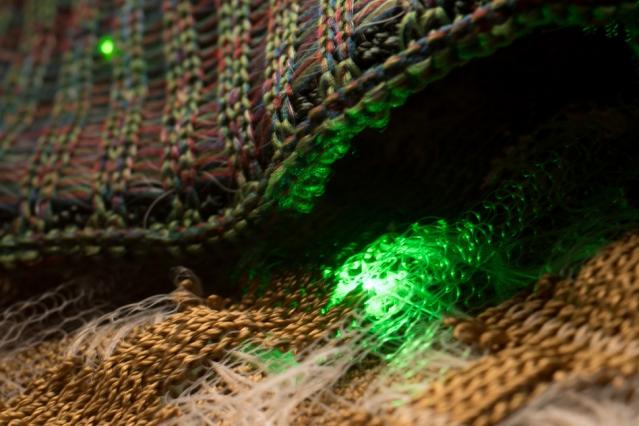
The new semiconductor embedded fabric is the missing link for a new generation of smart apparel for biomedical, military and communications applications. In the past few years, researchers have made significant progress in developing textiles including sensors and other electronic components to support the design of smart clothing. Now, a team at the Massachusetts Institute of Technology – working with other scientists – has made major breakthroughs in driving these technologies by developing fabrics embedded in semiconductors. Researchers believe that their findings can accelerate the development of wearable technology.
Specifically, researchers from academia and the private sector have embedded high-speed optoelectronic semiconductor devices into fiber optics and turned them into soft, washable fabrics that can be used as high-tech communication systems. Researchers at the Massachusetts Institute of Technology press conference said that Inman Mills of South Carolina created the fabric to produce a "software and hardware" that people can wear.
With ATX, you'll learn how to achieve ROI in smart manufacturing and other ways to stay ahead of the manufacturing industry. Meet with more than 450 suppliers to understand the role of virtual and augmented reality in manufacturing. Learn more!
Yoel Fink, professor of materials science and electrical engineering at the Massachusetts Institute of Technology, said: "We expect to see 'Moore's' simulated fibers in the next few years." The study was conducted by the Massachusetts Institute of Technology, Inman Mills, the American Advanced Functional Fabric Industry Organization (AFFOA). ), the Lincoln Laboratory and the EPFL in Lausanne, Switzerland, completed the collaboration. “It has allowed us to extend the basic functions of fabrics, including communications, lighting, physiological monitoring, etc.,†Fink said in the MIT release.
Fink, who is also the president of AFFOA, said that fabrics are the missing link in the real development of wearable technology, and will bring clothing to “value-added services, no longer just choose the era of aesthetics and comfortâ€. â€
Prefabricated parts are in tension
In the past, researchers have developed optical fibers by making a cylindrical object called a "preform" - basically an enlarged fiber model and then heating it. They then pull down the softened material under tension and collect the fibers that cause the spool. The researchers' work to produce new fibers is two important additions to the preform: the size of the light-emitting semiconductor diode is a grain of sand, and a pair of copper wires is a small part of the hair width.
The preform is heated in a furnace during fiber drawing to partially liquefy it to form long fibers which are arranged along their center and joined by copper wires. These diodes, including LEDs and photosensors, are rugged components fabricated using standard microchip technology. Researchers say they keep size, and everything shrinks around during the drawing process.
“This approach adds new insights into the process of making fiber,†said former Massachusetts Institute of Technology graduate Michael Ryan, who developed the concept that led to the new process. “We are not absorbing all the materials together in a liquid state, but mixing the equipment in the form of particles with thin metal wires.â€
They said the researchers washed the fabrics from which the fibers were woven 10 times to prove they were suitable for making clothes. They also tested its function in water by placing some photosensitizing fibers in a fish tank and survived there for several weeks.
The team published a paper on its work in Nature. The researchers' goal is to bring the first commercial products using this technology to the market as early as next year, Fink said, adding that the speed of laboratory-to-market development has been achieved through cooperation with AFFOA.
He said that the first products will focus on communication and security. “This will be the first fabric communication system,†Fink said. “We are now in the process of transforming technology to domestic manufacturers and industries at an unprecedented speed and scale.â€
Researchers say the other applications of the fabric include military use, and the Department of Defense is already exploring. It is also ideal for biomedical devices, using fiber to develop wearable technology to measure pulse or blood oxygen levels, or smart bandages to monitor healing.
Chiffon Fabric,Chiffon Material,Chiffon Cloth,Chiffon Fabric Dress
SHAOXING KAIMING TEXTILES CO.,LTD , https://www.kaimingtextiles.com